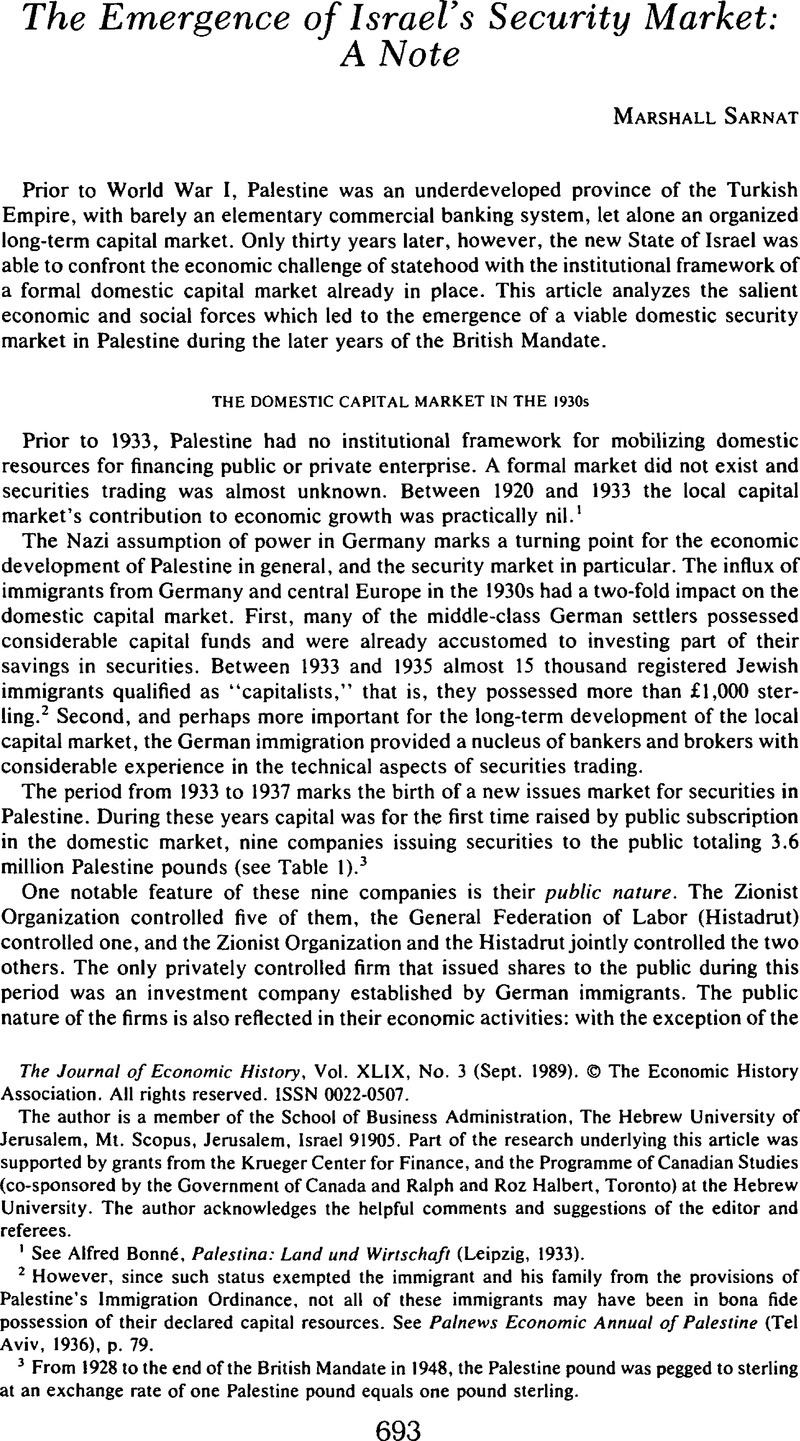No CrossRef data available.
Article contents
The Emergence of Israel's Security Market: A Note
Published online by Cambridge University Press: 03 March 2009
Abstract

- Type
- Notes and Discussion
- Information
- Copyright
- Copyright © The Economic History Association 1989
References
1 See Bonné, Alfred, Palesrina: Land und Wirtschafi (Leipzig, 1933).Google Scholar
2 However, since such status exempted the immigrant and his family from the provisions of Palestine's Immigration Ordinance, not all of these immigrants may have been in bona fide possession of their declared capital resources. See Palnews Economic Annual of Palestine (Tel Aviv, 1936), p. 79.Google Scholar
3 From 1928 to the end of the British Mandate in 1948, the Palestine pound was pegged to sterling at an exchange rate of one Palestine pound equals one pound sterling.Google Scholar
4 See Palnews Economic Annual of Palestine (1937), p. 210. A trust company in Germany owned by APB and two German Jewish banks acted as correspondants.Google Scholar
5 Quoted from Palnews Economic Annual of Palestine (1939), p. 169.Google Scholar In a somewhat broader context, the company viewed its primary objective as “promoting the immigration of German Jews,” ibid., p. 170.
6 During 1933/4 the Reichsbank allocated 2.3 million pounds for emigration transfers, see Palnews Economic Annual of Palestine (1938), p. 105.Google Scholar
7 See “Ha'avara Activities,” Palestine and the Middle East (1937), p. 407.Google Scholar
8 See Kahn, E., Der Effektenmarkt als Mittel zum Aufbau Palastinas (Jerusalem, 1937).Google Scholar
9 See “Ha'avara Activities,” p. 407.Google Scholar
10 Ibid.
11 See Kahn, Der Effektenmarkt als Mittel zum Aufbau Palastinas, p. 52.Google Scholar
12 Ibid. Kahn gives the following example. The immigrant pays RM 20.40 for a Palestine pound rather than the official rate of RM 12.38. He then effects an immediate transfer by purchasing PASA 4 percent bonds issued for this purpose at par, which on the open market subsequently could only be sold for, say, 70 percent of par. The combined exchange rate and security transfer losses in this case mean that in effect the immigrant transfered only 42 percent of his initial capital, valued at the official exchange rate. Kahn adds that even worse examples can be found. It should be noted that two decades later the West German government paid compensation to many of these immigrants for the “transfer losses” incurred in the 1930s. (1 am indebted to the late K. Klopfer for this observation.)
13 See Palestine Economic Review (1945), p. 14.Google Scholar
14 The economic development and structure of Palestine during the British Mandate are critically examined by Gross, N., “The Economic Policy of the Mandatory Government in Palestine,” Research in Economic History, 9 (1984);Google ScholarHalevi, N., “The Economic Development of the Jewish Community in Palestine 1917–1947,” Maurice Falk Institute for Economic Research in Israel, Discussion Paper 7914 (Nov. 1979);Google ScholarHalevi, N., Gross, N., Kleiman, E., and Sarnat, M., Banker to an Emerging Nation: The History of Bank Leumi Le-Israel (Tel Aviv, 1981);Google ScholarMetzer, J. and Kaplan, O., “Jointly but Separately: Arab-Jewish Dualism and Economic Growth in Mandatory Palestine,” this Journal, 45 (06 1985);Google ScholarNathan, R., Gass, O., and Creamer, D., Palestine: Problem and Promise (Washington DC, 1946);Google Scholar and Szereszewski, R., Essay on the Structure of the Jewish Economy in Palestine and Israel (Jerusalem, 1968).Google Scholar
15 The rapid expansion of manufacturing during the war years is examined by N. Gross and J. Metzer, “Palestine in World War II: Some Economic Aspects,” Maurice Falk Institute for Economic Research in Israel, Discussion Paper 8701 (Feb. 1987).Google Scholar
16 Ibid.


